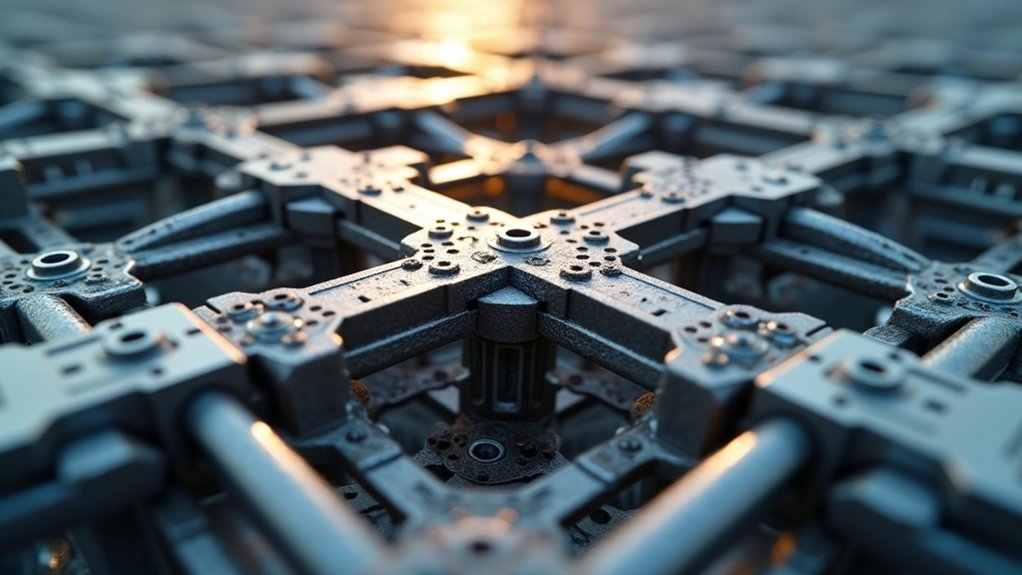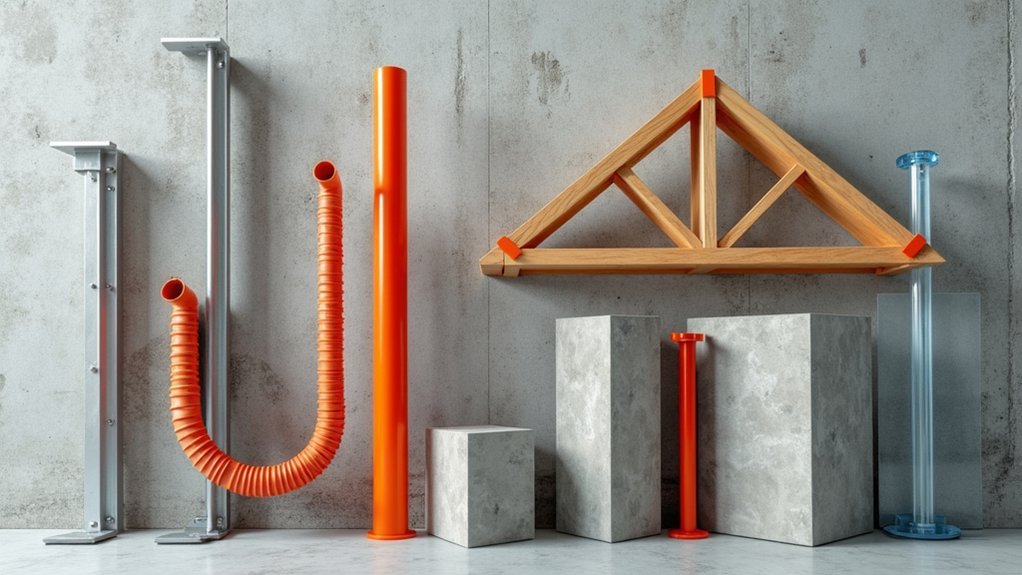You’ll need seven essential structural components for construction-scale 3D printing: reinforced wall systems with integrated cores and vertical #5 bars, post-tensioned foundation slabs using high-strength steel tendons, cross-tie connectivity systems at 18-inch intervals, vertical reinforcement elements for gravity resistance, horizontal reinforcement networks with #2 or #3 bars, composite beam integration combining steel’s tensile strength with concrete’s compressive capabilities, and advanced infill architectures like honeycomb patterns for optimized strength-to-weight ratios. These components work together to create buildings that exceed 4,000 psi compressive strength while meeting international building codes for lasting structural integrity.
Reinforced Wall Systems With Integrated Cores

When you’re considering structural components for construction-scale 3D printing, reinforced wall systems with integrated cores represent one of the most effective solutions for ensuring both strength and stability.
These systems feature a three-bead design that effectively resists gravity and lateral forces across various conditions. You’ll find that each bead is extruded as 3/4-inch tall by 2-1/2-inch-wide layers, creating a robust framework for your printed structure.
The integrated cores are reinforced with vertical #5 bars, providing exceptional resistance to both gravity and lateral loads.
These structural elements utilize Lavacrete, which achieves an impressive average 28-day compressive strength exceeding 4,000 psi—double the required 2,000 psi design strength. This performance meets building code requirements under Section R104.11 of the 2021 International Residential Code.
Post-Tensioned Foundation Slabs for Large Format Builds
As your construction projects scale to larger formats, post-tensioned foundation slabs become essential for achieving the structural integrity needed to support massive 3D-printed buildings.
Post-tensioned foundation slabs deliver the structural backbone that massive 3D-printed buildings demand as construction projects reach unprecedented scales.
You’ll benefit from high-strength steel tendons tensioned after concrete printing, enabling thinner slabs that greatly reduce material waste while maintaining superior performance.
This method minimizes cracking and deflection in large structures, extending your building’s lifespan.
You can achieve longer spans between supports, giving you greater design flexibility for expansive construction projects.
Post-tensioned slabs excel in challenging environments with expansive soils or heavy loads by distributing stress evenly across foundations.
You’ll also experience faster construction times and reduced labor costs, making this an economical solution for large-format printing applications.
Cross-Tie Connectivity Systems for Multi-Shell Structures

Multi-shell structural design demands robust connectivity between exterior and interior walls, and cross-tie systems deliver the critical linking mechanism that transforms separate shells into unified, high-performance assemblies.
You’ll enhance structural integrity by implementing C- or Z-shaped cross ties at 18-inch intervals, creating walls that resist both lateral and gravity forces effectively.
During 3D printing, you can incrementally place these connectors, maintaining precise alignment throughout construction. Your cross ties accommodate #2 or #3 horizontal reinforcement bars, ensuring ideal structural performance.
Vertical Reinforcement Elements for Load Distribution
Vertical reinforcement elements form the backbone of effective load distribution in 3D-printed construction, with #5 bars serving as the primary mechanism for resisting gravity loads and providing essential stability against both out-of-plane and in-plane forces.
You’ll find these vertical reinforcements strategically integrated into wall systems to enhance structural integrity throughout your building. The ICON 3-Bead Wall System demonstrates ideal placement at 18 inches on-center, ensuring compliance with safety standards while maximizing load-bearing capacity.
| Component | Spacing | Strength Benefit |
|---|---|---|
| #5 Bars | 18″ O.C. | Gravity Resistance |
| Vertical Cores | Strategic | Lateral Stability |
| Lavacrete Material | Continuous | 4,000+ PSI |
This three-bead design enables your structure to withstand lateral forces effectively, making it suitable for diverse environmental conditions while achieving compressive strengths exceeding 4,000 psi.
Horizontal Reinforcement Networks for Structural Stability

While vertical elements provide the foundational strength for your 3D-printed structure, horizontal reinforcement networks create the critical stability framework that ties everything together.
You’ll implement #2 or #3 reinforcing bars spaced 8 to 12 inches vertically within your printed wall shells, ensuring resistance against lateral forces while dramatically improving load-bearing capacity.
Your horizontal reinforcement networks integrate seamlessly during printing, eliminating labor costs associated with traditional methods.
You’ll place C- or Z-shaped cross ties 18 inches on-center, connecting exterior and interior shells to prevent separation under loading conditions.
This incremental placement strategy delivers exceptional structural stability.
Your 3D-printed walls will achieve compressive strengths exceeding 4,000 psi, doubling the 2,000 psi target requirement and demonstrating superior performance compared to conventional construction approaches.
Composite Beam Integration for Spanning Applications
When you’re integrating composite beams for spanning applications, you’ll need to carefully evaluate your beam material selection to match the specific load requirements and environmental conditions of your project.
Your load distribution methods must account for how forces transfer through the composite structure, ensuring peak performance across the entire span.
You’ll also want to design robust connection points that maintain structural integrity while accommodating the unique properties of composite materials.
Beam Material Selection
As construction projects demand increasingly efficient solutions for long-span applications, composite beams have emerged as the premier choice for engineers seeking ideal structural performance.
When you’re making beam material selection decisions, you’ll find that composite materials deliver exceptional high strength-to-weight ratios that traditional materials can’t match. You’ll reduce deflection while improving load distribution across spans, creating more efficient structural systems.
Consider integrating carbon fiber reinforced polymers (CFRPs) when you need maximum strength with minimal weight.
These advanced composites maintain structural integrity while considerably reducing overall beam weight. You’ll also benefit from enhanced resistance to bending, shear, and torsion forces, extending your structure’s lifespan.
Smart material selection optimizes construction costs while delivering superior performance for your spanning applications.
Load Distribution Methods
Building on smart material selection, effective load distribution becomes your next priority in maximizing composite beam performance across extended spans.
You’ll find that composite beam integration strategically combines steel’s tensile strength with concrete’s compressive capabilities, creating superior load distribution methods that outperform single-material alternatives. This approach lets you span greater distances while reducing support column requirements, maximizing usable space in your designs.
When you implement composite beams in 3D printing applications, you’ll achieve precise fabrication specifications while greatly minimizing material waste.
The controlled manufacturing process guarantees consistent quality and ideal material utilization. You’ll also discover that these load distribution methods enhance overall structural efficiency while lowering project costs.
Connection Point Design
The success of your composite beam spanning system hinges critically on connection point design, where structural loads transfer between elements with maximum efficiency and reliability.
You’ll enhance structural performance by integrating reinforced concrete and steel composites, which reduce weight while maintaining exceptional load-bearing capacity. Your connection points must distribute forces evenly across the structure, preventing stress concentrations that could lead to failure.
Advanced modeling techniques guarantee your designs meet safety standards and structural codes through precise performance calculations.
You’ll find 3D printing technology invaluable for streamlining construction processes, enabling rapid prototyping and testing of design variations before implementation. This approach allows you to optimize connection geometries, validate load transfer mechanisms, and achieve superior spanning performance in your composite beam systems.
Advanced Infill Architectures for Optimized Strength-to-Weight Ratios
When you’re designing structural components for construction 3D printing, you’ll need to choose between honeycomb and grid infill patterns based on your specific load requirements and material constraints.
Honeycomb structures excel at distributing loads evenly while maximizing material efficiency, but grid patterns offer easier printability and faster processing times.
You can optimize your component’s performance by strategically adjusting infill density—using 10-20% for non-critical areas and scaling up to 80-100% where maximum strength is essential.
Honeycomb Vs Grid Patterns
Two fundamental infill architectures dominate the conversation when you’re selecting patterns for construction-scale 3D printing: honeycomb and grid designs.
Honeycomb infill patterns deliver superior strength-to-weight ratios through their hexagonal structure, which distributes stress evenly and resists compression, buckling, and deformation. They’re your go-to choice for load-bearing applications, though you’ll need higher infill density to maximize their performance.
Grid infill patterns offer simplicity and speed while maintaining adequate structural support for less demanding components. You can optimize grid patterns by adjusting infill density to balance material usage with mechanical performance.
While grid designs print faster and use less material, honeycomb patterns consistently outperform them in structural integrity when you’re building components that’ll bear significant loads.
Density Optimization Strategies
Beyond selecting the right infill pattern, you’ll need to master density enhancement to achieve peak performance from your construction-grade 3D printed components.
You should implement high-density filling between 50%-100% for load-bearing elements, as this considerably enhances structural integrity compared to lower-density alternatives suitable only for decorative parts.
You can maximize efficiency by customizing infill density based on specific load requirements.
Apply varying densities throughout single components—use lower percentages in less critical regions while reinforcing high-stress areas with denser fills. This targeted approach reduces material costs and weight while maintaining structural resilience.
Advanced infill architectures like honeycomb or octet patterns distribute stress effectively while minimizing material consumption.
You’ll achieve ideal strength-to-weight ratios by strategically combining these patterns with appropriate density levels for each component’s function.
Frequently Asked Questions
Which Material Is Commonly Used in 3D Printing for Construction?
You’ll find Lavacrete is the most commonly used material in construction 3D printing. It’s a specialized concrete mix that exceeds 4,000 psi compressive strength, making it ideal for structural applications.
What Material Is Used in SDL 3D Printing?
You’ll use Lavacrete in SDL 3D printing, which is a proprietary concrete mix specifically engineered for construction applications. This material provides enhanced strength, durability, and workability for creating robust structural components.
What Are the 5 Elements of 3D Printing?
You’ll find 3D printing involves five key elements: your digital 3D model, the printer technology you’re using, your chosen material, the process parameters you set, and the slicing software controlling everything.
What Infill Should I Use for 3D Printing?
You’ll want 20-50% infill density for most projects, balancing strength and material efficiency. Use honeycomb patterns for lightweight strength or grid patterns for maximum durability in load-bearing applications.





Leave a Reply